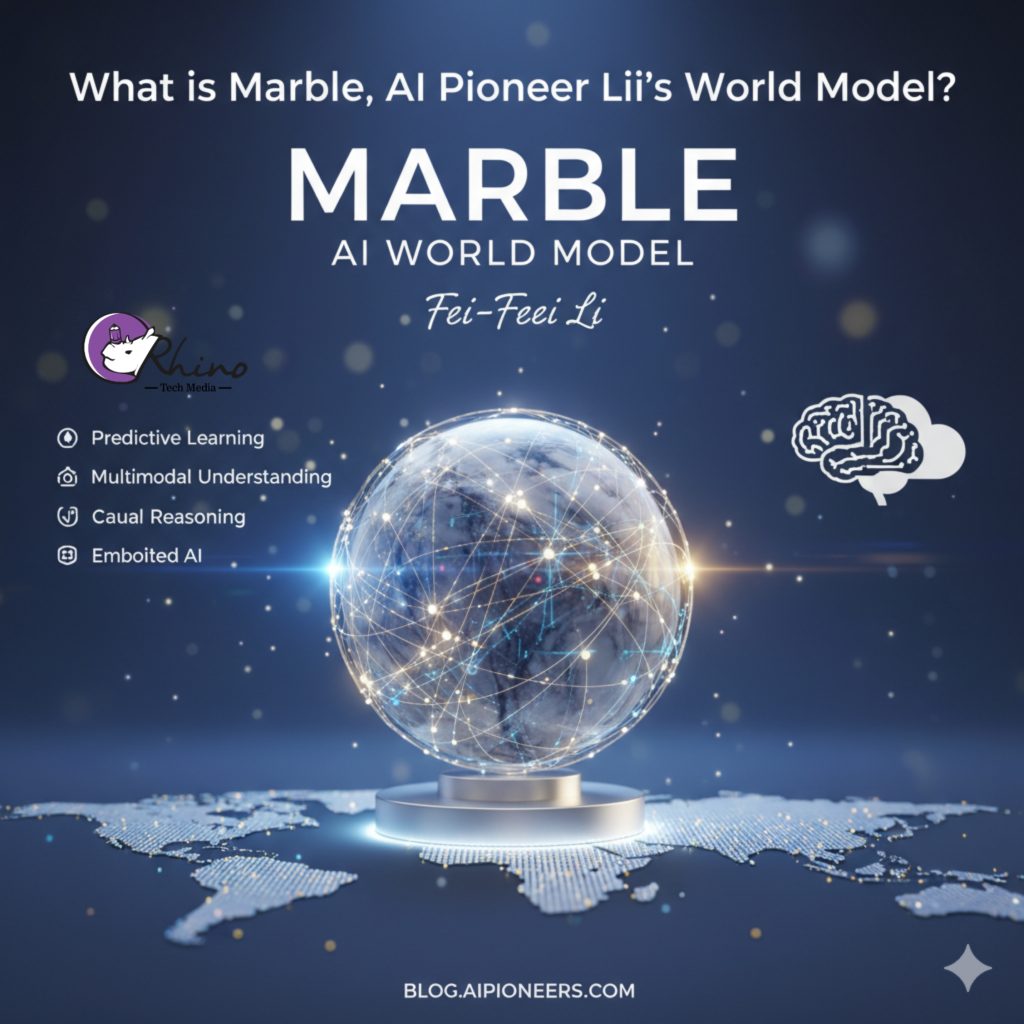Introduction
Fei‑Fei Li has long been a prominent figure in computer vision and artificial intelligence — from her leadership in developing ImageNet to her advocacy for “human-centred AI”. With her startup World Labs, she is now pushing into what she calls the next frontier: spatial intelligence. The company’s first commercial product, Marble, represents their vision of a “world model” — a system that doesn’t just process language or images, but understands, generates and enables interaction with full three-dimensional spaces. In the following essay I’ll explain what Marble is, the underlying idea of a world model according to Li and her team, how it works and what it signifies for the future of AI — as well as some of its limitations and implications.
What is a “world model” in this context?
In general AI research, a world model refers to an internal representation a machine builds of its environment — the objects in it, their relationships, how they move or change over time — in order to reason, plan, predict and act. For Li and her team at World Labs, the emphasis is on bringing this concept into 3D spatial environments: machines that don’t just “see” flat images or “read” text, but understand and generate spaces that have geometry, depth, movement, interaction.
As one article explains:
“The launch of Marble signals the next frontier in AI – spatial intelligence that needs powerful world models that reconstruct, generate, and simulate 3D models.”
Thus, the world model here is one that:
- can ingest multimodal inputs (text, image, video, 3D layout)
- can generate persistent 3D environments (not just a shimmering illusion)
- supports editing, expansion, interaction — enabling users (and potentially AI agents) to explore, manipulate, navigate the space
- is grounded in spatial logic (objects have depth, occlusion, geometry, consistent structure)
In Li’s own words:
“If large language models can teach machines to read and write, we hope systems like Marble can teach them to see and build. The ability to understand how things exist and interact in three-dimensional spaces can eventually help machines make breakthroughs beyond gaming and robotics.”
In short: the world model is a machine’s understanding of the physical/spatial world, and in this instance, a system that can generate such a world, not merely interpret or label it.
Spotlight on Marble: What it is and how it works
Marble is the first commercial product from World Labs aimed at realising this vision of spatially-intelligent world modelling. Here are its key characteristics:
Key features
- It enables users to generate 3D environments from text prompts, images (single or multiple), short video clips, or even rough 3D layout sketches.
- The worlds created are persistent and explorable: you can navigate through them, the geometry holds up, you can export them for use in other applications (meshes, Gaussian splats, video).
- It comes with editing tools: for instance, a feature called “Chisel” lets users block out coarse spatial structure (walls, planes) and then refine or style them via text/prompts.
- It supports output for creative and professional workflows: game development, VFX, VR/AR, architecture, robotics simulation.
- Commercial availability: after a preview, it has freemium and paid tiers, making it accessible beyond research labs.
What makes it different
Compared with earlier systems or research demos, Marble emphasizes scale, consistency, and editability:
- Rather than generating only small patches or single viewpoints, it claims to generate full rooms or worlds which you can freely explore — reducing issues like objects “popping in/out” when you change viewpoint.
- Rather than just auto-generating visuals, it supports a hybrid workflow: you define structure, prompt style, iterate — giving users more creative control.
- It handles multiple input types and allows outputs to be used in professional pipelines (exports to meshes, game engines).
Under the hood (as much as known)
While full technical details are not publicly disclosed, the available descriptions suggest the following:
- A multimodal model: text, image, video, geometry all feed into the system.
- It uses representations that support navigation and persistence — the world is not merely a rendered video but a space you can move within.
- The system supports export in formats like “Gaussian splats” (point-based/volume rendering), meshes, etc.
- The workflow supports incremental expansion: you generate a base world, then you can expand parts where detail is weak or new area is needed.
Why this matters: The significance of this world model vision
This development is important for several interlocking reasons:
For AI capability
- Most current generative AI systems centre on 2D media (text, images, video). Spatial intelligence — an AI’s understanding of 3D space, objects, physics, geometry, navigation — remains a frontier. The move from flat to three-dimensional is a leap.
- A true world model, in this sense, enables reasoning about “what happens if I move here”, “what’s behind that wall”, “how will light change”, “can an agent traverse this space”. These capabilities open doors for robotics, simulation, autonomous systems, virtual/augmented reality.
- For agents (robots or virtual), having a world model means being able to simulate outcomes, plan actions, test “what-if” scenarios — ultimately enabling more robust decision-making.
For creative professionals & industries
- Game development, VFX, film, architecture: building immersive 3D environments has historically been labour-intensive and time-consuming. A tool like Marble promises dramatic speed-up and accessibility.
- Virtual production, immersive storytelling, metaverse-type experiences: having tools that generate and allow navigation of large 3D worlds unlocks new forms of creativity.
- Training environments: for robotics, simulation of vehicles, even scientific modelling — you can generate a world to test an algorithm rather than always rely on real-world data.
For the broader AI narrative
- This work shifts the narrative from “large language model + image model” to “large world model” — that is, models that ground themselves in spatial and physical reality rather than purely symbolic or 2D data.
- In Li’s framing: “Our dreams of truly intelligent machines will not be complete without spatial intelligence.”
- It lays groundwork for future kinds of AI: not only generating content (images/videos) but generating environments and interactions within them.
Limitations, caveats, and open challenges
As promising as Marble and its underlying vision are, there are important limitations and questions ahead:
- Interactivity vs static worlds: While Marble allows exploration, full physical interaction (agents moving, objects responding, physics simulation) appears to be limited at present. For example, one commentary noted: “It’s still early … generates only a ‘shell of world space’, with limited visual accuracy, local blurriness, and lacking interactive lighting changes or physical phenomena.”
- Real-time dynamic environments: Some competitors focus on real-time physics/agent interaction (e.g., generative agents in simulation). Marble presently emphasises generation of a world rather than continuous real-time simulation of interactions.
- Scale and generalisation: Generating very large, highly varied worlds, or worlds that accurately model real-world physics at high fidelity remains challenging. Edge cases, complexity of real-world object diversity, accurate lighting, material physics — all remain research frontiers.
- Data & training implications: Building world models requires immense datasets of 3D/4D data, spatial relationships, physics. Ensuring adequate coverage, generalisation, avoiding biases, ensuring safety/accuracy is non-trivial.
- Ethical, economic and societal impacts: As with other generative AI tools, questions arise about job displacement (in creative industries), copyright/asset origin, misuse of generated worlds (e.g., deep-fake environments), and the environmental cost of large-scale 3D generation.
- “What counts as understanding?”: Generating a navigable 3D world is impressive, but true world models might require reasoning about causality, agent behaviour, simulation of changes over time, adaptation when the world changes. How Marble stacks up in that dimension remains to be seen.
What the future might hold
Given the direction set by Marble and Li’s vision, we can anticipate several possible developments:
- Integration of agent-based simulation: Future versions may allow not just world generation, but active simulation of agents interacting in that world (robots, avatars, autonomous systems).
- Higher fidelity physics and temporal simulation: Including lighting changes, dynamic object movement, real-time modification of worlds as events occur.
- Broader domains: Beyond gaming and VR, world models could be used for scientific simulation (e.g., molecular/chemical worlds mapped into 3D simulation), architectural design (digital twins of real buildings), robotics training (simulated worlds for robot navigation, manipulation). Li herself suggests applications in science, medicine, architecture.
- Hybrid real + virtual worlds: Digital twin environments of real spaces (cities, factories) could be generated, navigated, edited — enabling simulation, planning, training in realistic virtual replicas.
- Accessibility & democratization: As tools like Marble mature, we may see a shift where 3D world creation becomes accessible to non-experts — much like image generation is becoming. This would expand creative possibilities widely.
- Convergence with AR/VR: With spatial AI and world models, immersive augmented reality environments that meaningfully integrate generated 3D worlds with the user’s physical space may become more seamless.
- Ethical frameworks & standards: As world models proliferate, we will need governance for generation of virtual spaces (misinformation, deep-fake environments, asset provenance, copyright, simulation realism).
Conclusion
Marble, from World Labs under Fei-Fei Li’s leadership, is a compelling step toward realizing world models — AI systems that understand, generate, and enable navigation in three-dimensional spaces. It pivots the AI frontier from “2D text/image/video” toward “3D spatial intelligence” and opens new creative, scientific and technological horizons.
While still in its early stages, with limitations around full interactivity, physics, fidelity, and simulation depth, the significance lies in the direction: building models that can see, build, reason about the physical world. As Li frames it: “Our dreams of truly intelligent machines will not be complete without spatial intelligence.”
In short: Marble is more than a fun tool for generating 3D scenes. It is a harbinger of a shift in AI’s ambition — toward machines that don’t just process symbols or flat images, but operate in the world, generate worlds, and perhaps eventually act meaningfully within them.

